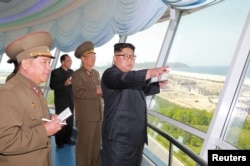Planning is under way in South Korea to renew and expand tourism ties with North Korea, contingent upon the lifting of economic sanctions that the U.S. insists will remain in place until Pyongyang dismantles its nuclear arsenal.
The South Korean Incheon Port Authority (IPA) on Monday announced plans to facilitate foreign cruise ship visits to both South and North Korean ports, according to the Yonhap news service. Next year, South Korea will also open the nation's largest cruise ship terminal in Incheon.
Harry Baek, the CEO of Lotte Tour, said that expanding the South Korean cruise industry to include visits to the North Korean coastal city of Wonsan could make Northeast Asia a major tourist destination.
“If inter-Korean relations and the relations between the U.S. and North Korea improve in the future, the route that connects the Wonsan port in North Korea, with Vladivostok in Russia, Hokkaido, Aomori in Japan, Busan and Jeju, while having Sokcho (in South Korea) as a home port, a [rival] second Caribbean sea market in Northeast Asia will be created,” said Baek.
However, Baek also emphasized that no official planning is underway for expanding operations, and that the South Korean tour industry is in full compliance with United Nations sanctions. The tough international restrictions block most financial transactions and 90 percent of all trade with North Korea, so as to cut off funds for Pyongyang’s threatening nuclear and missile development programs.
North Korean Leader Kim Jong Un and South Korean President Moon Jae-in agreed to pursue increased economic cooperation when they met in April. While the Seoul government has said it will enforce sanctions prohibiting economic ventures, it may seek waivers for joint projects that promote cross border exchanges and cooperation.
Peace dividend
Currently, the Caribbean region is the top cruise destination, with over 35 percent of an international cruise market that draws more than 26.6 million people a year, according to Lotte Tour. Mediterranean cruises captured more than 15 percent the market while cruises to Asia accounted for about 10 percent.
The Lotte Tour CEO estimates that if tensions ease and restrictions are lifted, international interest in visiting North Korean destinations like Wonsan on the coast and the capital, Pyongyang, would likely double the annual number of cruise tourists to Asia.
North Korea has also been investing in building what looks like tourism villages in the coast city of Wonsan, according to Ian Bennett, a manager with Choson Exchange, a non-profit organization that provides business training to North Korean entrepreneurs and organizations.
“I think from their side the will is certainly there and there would certainly be a great deal of interest from the South, obviously tempered by a bit of caution,” said Bennett.
Safety concerns
Safety and security for visitors in North Korea would be a top concern for tour groups, especially after last year’s death of Otto Warmbier, an American student who was arrested while visiting North Korea in 2016 for allegedly attempting to steal a propaganda poster. He fell into a coma while in jail and was held in that state for over a year before he was released and subsequently died a few days later.
In response to another deadly incident in 2008, South Korea suspended tours to the Kumgang tourist zone after a North Korean soldier shot a visitor. In 1998 Former Hyundai chairman Chung Mong-hun led efforts to build the North Korean mountain resort that had attracted nearly two million South Korean tourists a year and generated millions of dollars until it was shut down after that incident.
Sunshine policy
The Kumgang tourism project was a key part of the Sunshine policy initiated by a previous progressive government in Seoul on the premise that the North and South could build trust through joint projects that would lead to peaceful co-existence and to some form of unification.
“When you visit we tend to find out they're not all robots, and when they meet us they find out that we are not all imperialists. There’s a lot of learning and a lot of breaking down of preconceptions on both sides,” said Bennet.
Last week, Hyun Jeong-eun, the current chairwoman of the Hyundai Group, expressed optimism that tours to the Mount Kumgang resort would resume later this year. And Hyun said she had been in contact with North Korean officials who also expect the resort to reopen soon.
Hyun had visited the resort in North Korea to attend a memorial for her late husband Chung, the former Hyundai leader. Hyundai Asan declined any further comment on the possible reopening of the site.
Tensions downturn
While visitors may flock to the Korean Peninsula if it becomes a peaceful and nuclear free zone, a return to confrontational polices could cause a downturn in tourism.
“If there are missiles, the demand will shrink. Foreign tourists will avoid the route and the number of tourists will drop,” said Baek.
Last year China also imposed temporary restrictions on tours to South Korea in protest to the Seoul government’s decision to deploy the U.S. THAAD missile defense system. Beijing says the THAAD’s powerful radar system could be used to monitor China's military installations.
Lee Yoon-jee contributed to this report.








